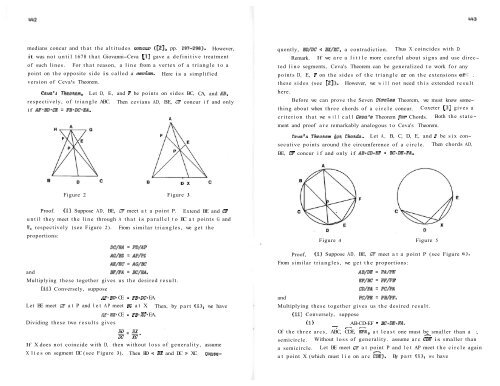Vol. 8 No 7 - Pi Mu Epsilon
Vol. 8 No 7 - Pi Mu Epsilon
Vol. 8 No 7 - Pi Mu Epsilon
You also want an ePaper? Increase the reach of your titles
YUMPU automatically turns print PDFs into web optimized ePapers that Google loves.
medians concur and that the altitudes concur ([2], pp. 297-298). However,<br />
it was not until 1678 that Giovanni-Ceva [I] gave a definitive treatment<br />
of such lines. For that reason, a line from a vertex of a triangle to a<br />
point on the opposite side is called a oevian. Here is a simplified<br />
version of Ceva l s Theorem.<br />
Ceua'h Theohem. Let D, E, and F be points on sides BC, CA, and AS,<br />
respectively, of triangle ABC. Then cevians AD, BE, CF concur if and only<br />
if AF-BD-CE = FB-DC-EA.<br />
A<br />
quently, BD/DC < BX/XC, a contradiction. Thus X coincides with D.<br />
Remark. If we are a little more careful about signs and use directed<br />
line segments, Ceva's Theorem can be generalized to work for any<br />
points D, E, F on the sides of the triangle or on the extensions of-' -<br />
these sides (see [2]). However, we will not need this extended result<br />
here.<br />
Before we can prove the Seven Circles Theorem, we must know something<br />
about when three chords of a circle concur. Coxeter [3] gives a<br />
criterion that we will call Ceva's Theorem for Chords. Both the statement<br />
and proof are remarkably analogous to Ceva's Theorem.<br />
Ceua'h Theohem ~ O ChohdA. A<br />
Let A, B, C, D, E, and F be six con-<br />
secutive points around the circumference of a circle.<br />
BE, CF concur if and only if AB-CD-EF = BC-DE-FA.<br />
Then chords AD,<br />
Figure 2 Figure 3<br />
Proof. (i) Suppose AD, BE, CF meet at a point P. Extend BE and CF<br />
until they meet the line through A that is parallel to BC at points G and<br />
H, respectively (see Figure 2). From similar triangles, we get the<br />
proportions:<br />
and<br />
DC/hM = PD/AP<br />
AG/BD = AP/PD<br />
AE/EC = AG/BC<br />
BF/FA = BC/E4.<br />
<strong>Mu</strong>ltiplying these together gives us the desired result.<br />
(ii) Conversely, suppose<br />
AP BD- CE = FB- DC- EA.<br />
Let BE meet CF at P and let AP meet BC at X.<br />
Dividing these two results gives<br />
AF- BE CE = FB- XC- EA.<br />
Then, by part (i), we have<br />
If X does not coincide with D, then without loss of generality, assume<br />
X lies on segment DC (see Figure 3). Then BD < EX and DC > XC. Conse-<br />
Figure 4 Figure 5<br />
Proof, (i) Suppose AD, BE, CF meet at a point P (see Figure 4).<br />
From similar triangles, we get the proportions:<br />
and<br />
AB/DE = PA/PE<br />
EF/BC = PF/PB<br />
CD/FA = PC/PA<br />
PC/PE = PB/PF.<br />
<strong>Mu</strong>ltiplying these together gives us the desired result.<br />
(ii) Conversely, suppose<br />
(1 AB-CD-EF = BC-DE-FA.<br />
-. n P<br />
Of the three arcs, ABC, CDE, EFA, at least one must be smaller than a i<br />
semicircle. Without loss of generality. assume arc CUE is smaller than<br />
a semicircle. Let BE meet CF at point P and let AP meet the circle again<br />
c<br />
at point X (which must lie on arc CUE). By part (i), we have<br />
-
















